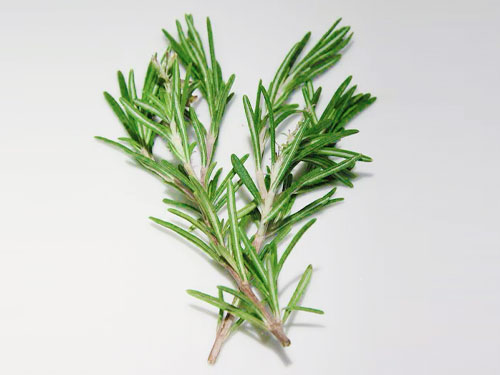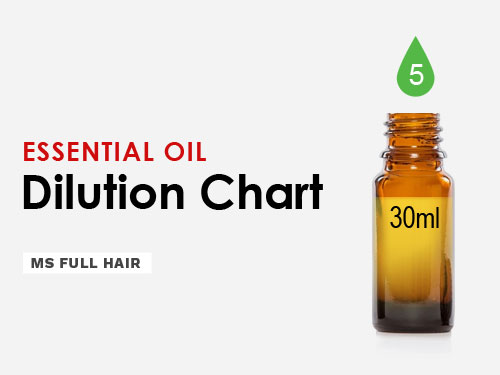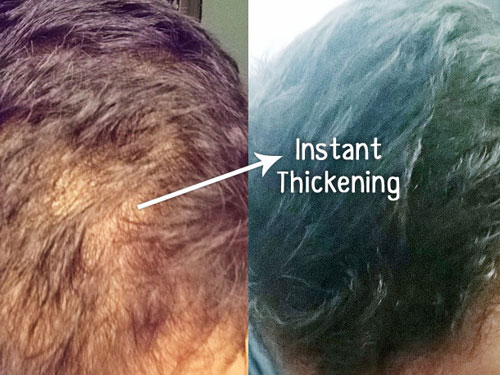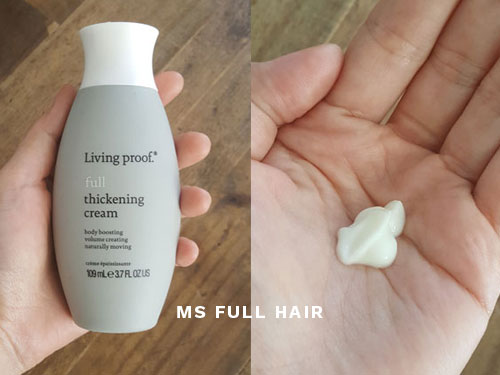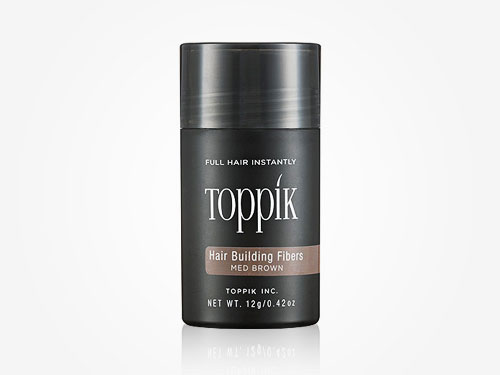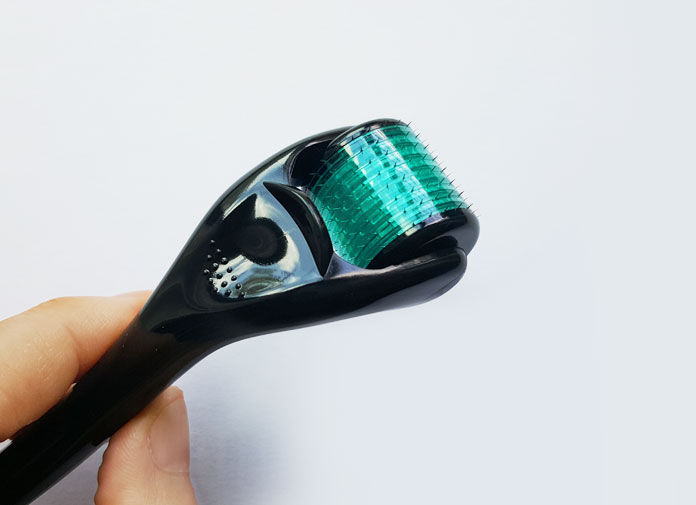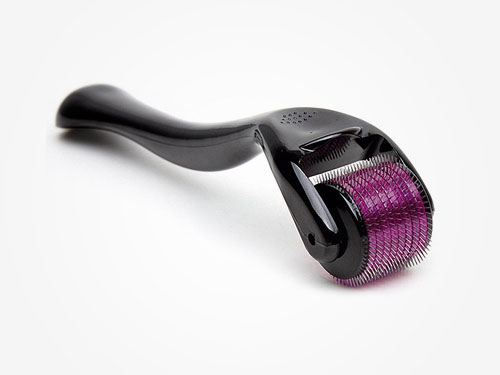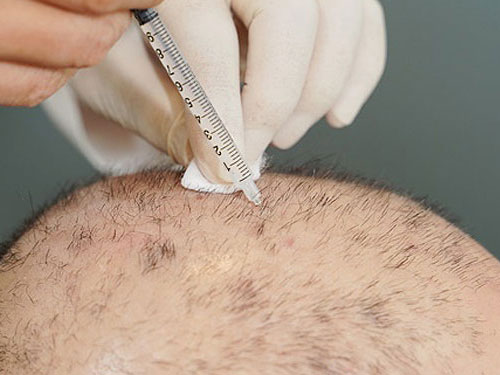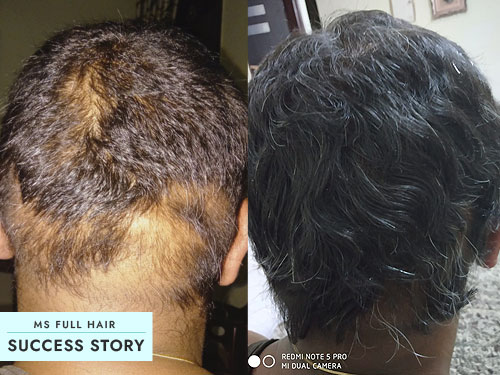Studies show that microneedling works surprisingly well for stimulating hair regrowth. People experiencing hair loss often use a derma roller in conjunction with minoxidil or other natural topical treatments to expedite the growth process.
Benefits
✓ Prevents hair loss
✓ Stimulates hair regrowth
✓ Reduces hair thinning
Growth Recipe?
Yes (See Below)
If you think dermaroller microneedling is only for anti-aging, think again.
For the last 5-7 years, using a derma roller for hair growth has become one of THE most common practice among hair loss sufferers.
Unlike many other come-and-go hair growth gadgets or remedies, microneedling is not going anywhere anytime soon and for a great reason.
In this ultimate guide, we will give you everything you need to know about microneedling for hair loss.
First, you will learn how dermarolling helps with hair loss.
Then, we will cover ALL of the microneedling for hair loss studies and give you key findings from each one.
You will also see 5 derma roller for hair regrowth success stories with before and after photos (as well as their regimens).
Finally, you will learn how to use a derma roller for maximum hair growth results, along with the best dermaroller for hair regrowth to use on a weekly basis.
First, let’s cover some basics:
What is microneedling?
Microneedling definition: Microneedling, also known as derma rolling, is a simple dermatologic procedure.
Made of hundreds of needles, this hand-held device is designed to be rolled over the skin for the purpose of puncturing the outmost layer (stratum corneum).
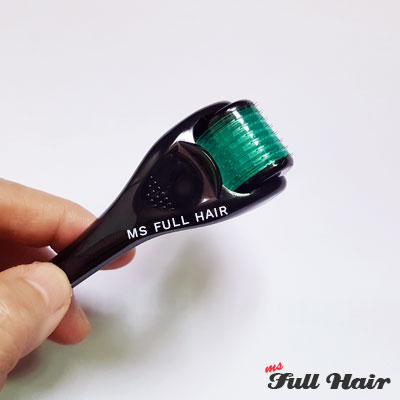
Interestingly, the official medical term for micro needling is percutaneous collagen induction therapy.
As the term indicates, when needles puncture tiny holes into the skin it creates small wounds due to an acute inflammatory response.
However, the wounds are just deep enough to induce the repairing process without scarring the tissues.
The repairing process is what actually increases the production of collagen.
Due to this simple yet effective mechanism, microneedling has been a huge hit in the skincare industry.
Some of the popular cosmetic uses include:
- Reducing fine lines as well as deep wrinkles
- Improving dark circles
- Removing acne scars
- Fading cellulite and stretch marks
- Evening out skin depigmentation
The popularity of microneedling hair loss at home therapy: What’s even better, an increasing number of research studies also prove that a dermaroller also works wonders regrowing hair for all kinds of alopecia including androgenic alopecia (AGA) and alopecia areata (AA).
Microneedling benefits for hair loss – How a dermaroller helps with hair growth
From a handful of studies, researchers discovered a mechanism behind microneedle hair regrowth relations and why a derma roller improves a hair loss condition in such a dramatic way.
Here are the main benefits of microneedling for hair loss from the studies.
How does microneedling for hair loss work? 3 Major benefits:
Benefit #1 – Microneedling promotes a better delivery of topical hair loss treatments
One of the biggest obstacles of using any skin care product is permeability.
Our skin (stratum corneum specifically) acts as a protective barrier.
This also means that even if you use a topical serum made with the best hair growth ingredients, the chances of getting them all to penetrate the skin is extremely slim.
This is where micro needling can come in very handy.
Derma roller benefits for hair: A 1998 study (1) notes that derma rolling help cross this permeability barrier without damaging any nerves.
For instance, when the researchers tested the absorption of calcein (fluorescent dye used to indicate cellular health), the increase was 1000 times after microneedling.
As the needles are rolled over the scalp, it creates tiny holes in the outer layer of epidermis, which allows topical treatments (minoxidil or any topical solutions) to easily enter and absorb into the skin.
Benefit #2 – Microneedling increases the formation of new blood vessels in the scalp (angiogenesis)
Micro-puncturing causes cutaneous wounds (micro injurious) in the scalp that is not too deep to become scar tissue.
Our body then automatically starts the wound repairing process by sending various signaling proteins and hormones to the area.
One of the signaling proteins that interacts with the repairing process is called vascular endothelial growth factor (VEGF).
The main role of VEGF is to promote the formation of new blood vessels (known as angiogenesis) in the outer root sheath of hair follicles, thus providing the surrounding hair follicles with better blood supply via vascularization.
These newly created blood vessels then help accelerate hair regrowth by supplying better nutrition to follicles and keeping the strands in the anagen (growth) phase for a longer period of time.
Benefit #3 – Microneedling activates various growth factors associated with the development of hair follicles
Microneedling increases the following growth factors:
- Platelet derived growth factor
- Vascular endothelial growth factor (discussed above)
- Epidermal growth factor
- Fibroblast growth factor
These growth factors via micro needling activate Wnt/β-catenin signaling pathways – one of the most important elements for hair follicle development / regeneration and hair growth (2).
Wnt/β-catenin signaling assists with hair follicle development by proliferating hair cells from derma papilla, outer root sheath and hair matrix.
It also initiates the anagen (hair growth) phase and maintains hair morphogenesis.
A 2011 study (3) notes the importance of β-catenin molecules for hair growth. The researchers discovered that minoxidil works by stimulating β-catenin proteins in the derma papilla cells, leading to the extension of the anagen phase of hair follicles.
Another study (4) observed that when β-catenin was absent, a complete hair loss occurred in mice due to the failure of stem cells to transform into follicle cells.
Microneedling hair regrowth studies
When we first wrote about using a derma roller for hair loss, there were only a few studies available on this subject.
Since then, the popularity of microneedling has dramatically grown over the years thanks to continuous studies and their very promising baldness reversal results.
Here, we have gathered ALL the existing microneedling hair regrowth studies (as far as we were able to find) and share a summary and key findings from each study.
Microneedling hair loss study #1:
Identifying the optimal derma roller for hair loss size & cycles for inducing hair growth
In this 2016 study (5), a team of Korean researchers used various needle lengths and cycles, in order to find out what combination would create the best hair regrowth results.
Tested on mice, four different needle lengths were used in the experiment: 0.15 mm, 0,25 mm, 0.5 mm, and 1 mm.
The researchers also varied the number of cycles from 3, 6, 10 to 12 of rolling over the skin.
Detailed microneedling procedure:
- Type: Disc derma roller (best result seen in 0.25 mm & 0.5 mm)
- Frequency: 5 times a week
- Cycles: 10 each session (best result)
Duration: 3 weeks
The result?
More, longer needle sizes do not improve the results, contrary to what many may think.
Here are the dermaroller for hair loss before and after results:
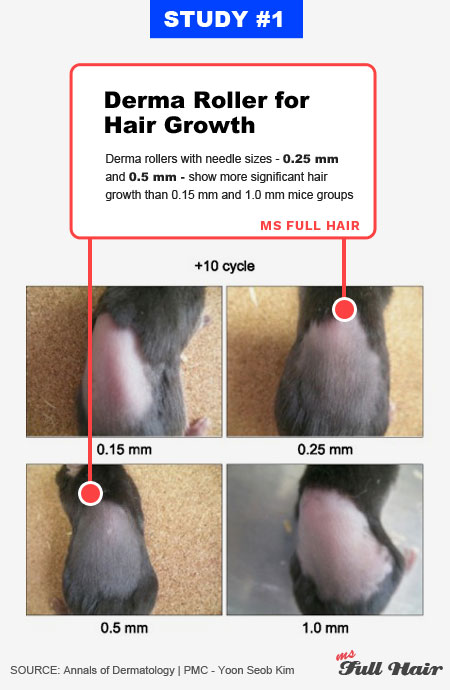
Instead of the 1 mm derma roller, the longest needle length used in the experiment, 0.25 mm or 0.5 mm turned out to be the best derma roller for hair growth needle size for treating hair loss.
Also, the researchers observed the best outcome using a period of 10 cycles, instead of 12.
Study takeaway
- 0.25 mm / 10 cycles and 0.5 mm / 10 cycles turned out to be the most optimal needle length and cycle combination for stimulating hair growth when tested on mice.
- Interesting fact: The study used a disc-based derma roller (not an individual needle derma roller).
- Limitation: This study was done in mice instead of on humans.
Microneedling hair loss study #2:
Identifying the efficacy of microneedling for androgenic alopecia (pattern hair loss)
In this study (6) 100 male participants with mild to moderate male pattern hair loss were randomly divided into two groups. In order to find out the effectiveness of microneedling, the researchers used the most common hair regrowth treatment – Minoxidil.
Study design:
- Group A: 5% Minoxidil
- Group B: 5% Minoxidil + 1.5 mm dermaroller
In order to increase the accuracy of the result, all participants initially shaved their heads.
Group A (5% minoxidil) was instructed to apply 1 ml of minoxidil twice a day, while group B (minoxidil + microneedling) also applied minoxidil in the same manner, in addition to a weekly microneedling therapy.
Detailed microneedling procedure:
- Type: 1.5 mm needle size dermaroller
- Frequency: once a week
- Directions: The needles were rolled over the scalp in a longitudinal, vertical and diagonal direction until the applied area of the scalp became red (It doesn’t specify the exact number of cycles).
- Note: Minoxidil was NOT applied on the day of microneedling.
Duration: 12 weeks
The result?
Simply astonishing!
Here are the micro needling for hair loss before and after photos:
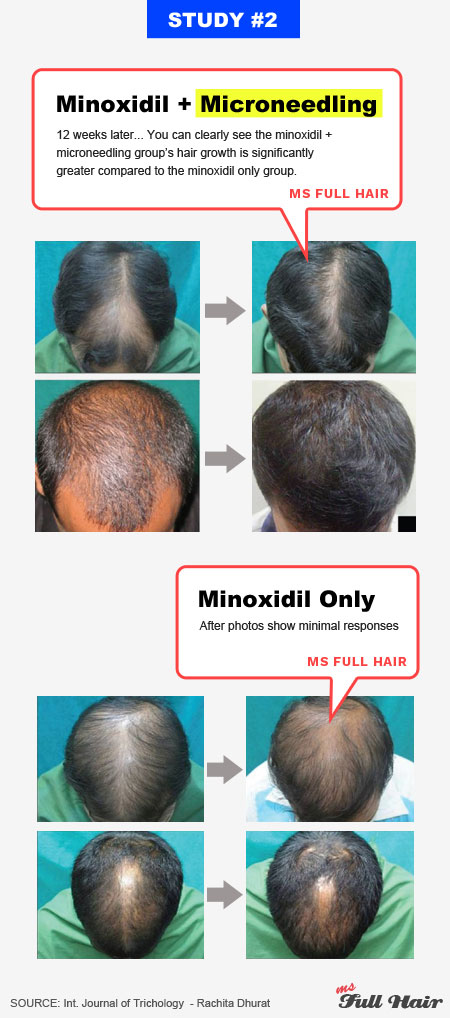
This study in fact is the beginning of what motivated numerous people to start using a dermaroller.
Group B participants (minoxidil + dermarolling) had almost 5 TIMES MORE HAIR COUNT than the group A (minoxidil alone) participants. To be exact, the mean change in hair count was 91.4 vs 22.2 (Group B vs Group A):
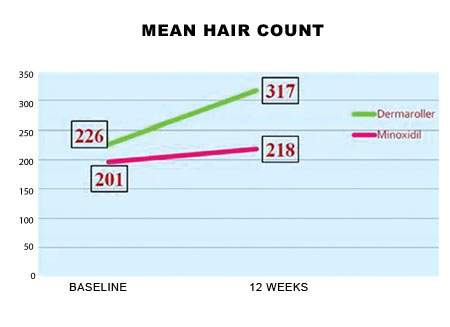
In other words, the result is an indication that minoxidil indeed works.
But if you use it in conjunction with a derma roller, this combo speeds up hair regrowth in a dramatic manner!
Study takeaway
- Using minoxidil in conjunction with microneedling stimulates rapid hair regrowth (5 TIMES MORE) than using minoxidil alone
- The best hair regrowth result procedure: derma rolling once a week + minoxidil twice a day
Microneedle hair loss study #3:
Identifying if micro-needling stimulates hair regrowth with or without minoxidil
This experiment (7) is similar to the above study #2, but there is one extra group added to the study design: microneedling-only participants.
A total of 60 participants with thinning hair due to androgenic alopecia were entered into the study. This time, the participants were divided into 3 groups.
Study design:
- Group A: 5% Minoxidil
- Group B: Microneedling
- Group C: 5% Minoxidil + microneedling
The researchers instructed the participants to apply 1 ml of 5% minoxidil twice a day (a total of 2 ml a day).
For group C (minoxidil + microneedling), minoxidil was delivered into the scalp during the microneedling session. Right after microneedling, a scalp massage was performed to encourage better absorption of minoxidil.
Detailed microneedling procedure:
- Type: 1.5 – 2.5 mm adjustable size electric microneedle pen with 9 needles
- Cycles: 3-4 times (until the scalp became red)
- Frequency: 6 times a week (The study states 12 microneedle hair loss treatments every 2 weeks)
- Note: Scalp massage was performed right after derma rolling.
Duration: 24 weeks (6 months)
The results?
Once again, group C (minoxidil + microneedling) was a clear winner. Here are microneedling for hair loss before and after photos:
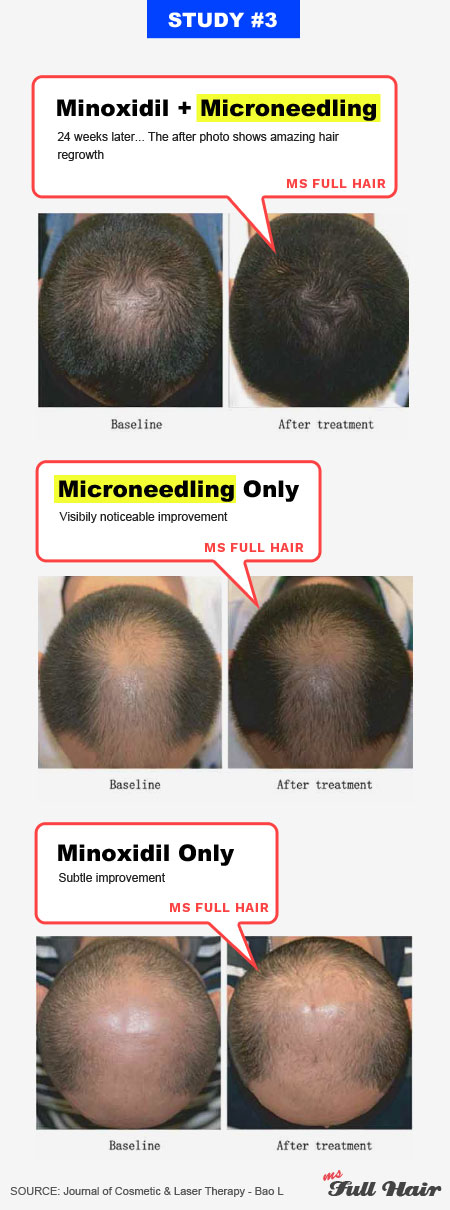
Here are the specific numbers:
Hair counts (hair density) increase:
- Group A: 18.8 / cm2
- Group B: 23.4 / cm2
- Group C: 38.3 / cm2
Non-vellus Hair thickness increase:
- Group A: 10.7 μm
- Group B: 3.2 μm
- Group C: 11.8 μm
As you can see, participants in group C had far better hair growth results than group A and group B, especially the number of hairs.
What’s interesting from the above data is that using a dermaroller for hair loss without minoxidil is also effective for stimulating hair.
If you compare the increase in hair counts, microneedling indeed worked better than minoxidil.
Study takeaway
- Microneedling plus minoxidil again showed the best hair regrowth result in both hair counts and thickness.
- Microneedling the scalp without minoxidil (or any topical treatment) is also effective to some extent.
- The best hair growth result procedure: derma rolling 6 times a week + minoxidil twice a day
Microneedling hair loss study #4:
Identifying the efficacy of microneedling with or without minoxidil
This case study (8) is almost the same as the above studies, except for the total duration and number of participants.
Two participants with androgenetic alopecia were involved in the study. Both participants previously used finasteride, but quit due to side effects.
Study design:
- Participant A: Microneedling (3 sessions) + 0.5% minoxidil
- Participant B: Microneedling (4 sessions)
For the microneedling procedure, a tattooing device was used instead of a derma roller to puncture tiny holes into the scalp. The device also had a container used to release minoxidil as the needles entered into the skin.
For the second patient, the same tattoo device was used, but without minoxidil.
Detailed microneedling procedure:
- Type: 1.5 mm tattoo apparatus with 17 needles
- Frequency: once a week
- Directions: Repeating the microneedling until pinpoint bleeding appears
Duration: 1 month
The result?
Le’ts start with microneedling before and after results of hair growth:
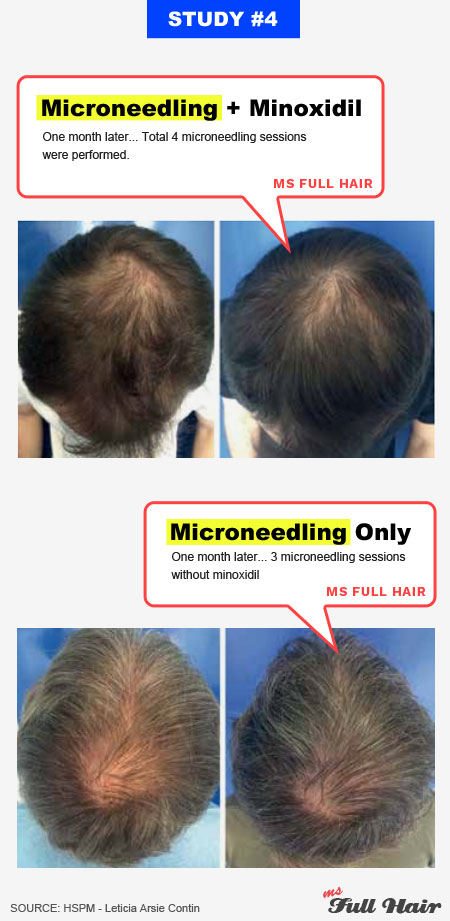
There are two things we want to discuss:
First, can you tell which participant was treated with or without minoxidil just looking at the photos?
Without a caption, it’s hard to tell who was treated with minoxidil and microneedling vs microneedling only, because the overall improvement is somewhat similar.
This may be due to the fact that the strength of minoxidil was much weaker (0.5%) compared to other studies (5%).
Second, while the after photos do not show complete recovery of either participant, it’s important to point out that the after photos were taken only after one month passed.
In other words, you can expect to see hair regrowth results in as early as one month (or as little as 3 micro needling sessions).
Study takeaway
- The strength of minoxidil may affect the level of hair regrowth
- This study proves once again that microneedling as a monotherapy promotes new hair growth
Microneedling hair loss study #5:
Identifying if microneedling also works for alopecia areata
While most microneedle hair loss studies are based on treating androgenetic alopecia (pattern hair loss), one study (9) shows that you can also use a derma roller for alopecia areata (bald patchy hair loss).
Two patients with extensive alopecia areata were examined here.
It’s important to note that both patients previously tried conventional alopecia areata treatments which included triamcinolone acetonide intralesional injections, topical steroid creams and minoxidil; however, these therapies didn’t improve their non-scarring hair loss conditions.
In this experiment, both patients used a derma roller and topical triamcinolone acetonide (corticosteroid).
Study design: Microneedling + topical triamcinolone acetonide (with 10 ml/ml concentration)
Topical triamcinolone acetonide was applied before and after derma rolling the scalp.
Detailed microneedling procedure:
- Type: 1.5 mm derma roller with 192 needles
- Directions: diagonally, vertically, and horizontally 4-5 times in each direction after a topical application
- Cycles: 4-5 times in each direction
- Frequency: once a week
Duration: 3 weeks
The result?
Here are the before and after photos of using a dermaroller for alopecia areata hair loss:
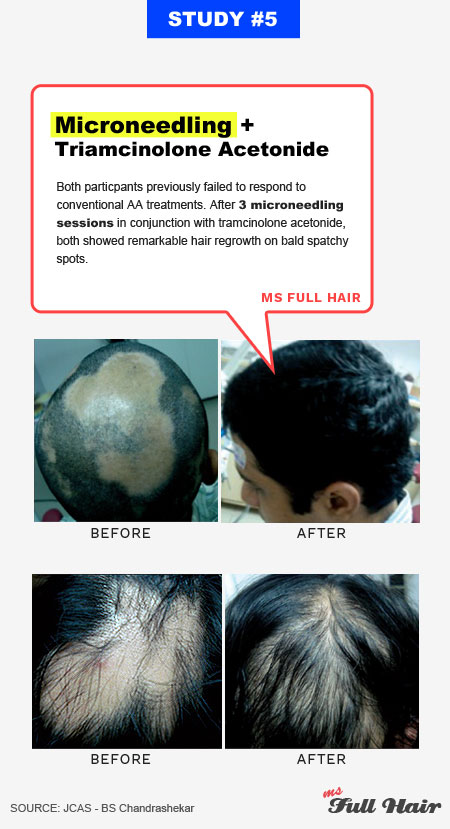
The transformation is truly amazing!
The male participant shows FULL hair recovery, while the female participant had significant improvement on what previously was a big bald bare spot.
Another thing to note here is that it only took 3 WEEKS to see the result.
Study takeaway
- Microneedling also accelerates hair regrowth for alopecia areata when used with triamcinolone acetonide.
- If you are recalcitrant to conventional AA therapies, consider using a derma roller.
- Limitation: It would’ve been great if the study also had a control group – triamcinolone acetonide only.
Microneedling hair loss study #6:
Finding out the efficacy of minoxidil-only and minoxidil + microneedling with PRP for hair loss
A 2017 study (10) reports that combining platelet rich plasma (PRP) and microneedling treatments stimulates hair regrowth.
Here, 50 participants with AGA were randomly divided into two groups.
Study design:
- Group A: 5% minoxidil
- Group B: 5% minoxidil + microneedling with PRP
Group A was instructed to apply 1 ml of minoxidil twice a day.
Group B also received the same instruction (applying minoxidil twice daily), but with the addition of performing derma rolling and PRP injection once a month for 6 months.
Detailed microneedling procedure:
- Type: 1.5 mm size derma roller
- Directions: Roll over the derma roller in diagonal, longitudinal, vertical directions
- Cycles: 8 times in each direction (until the applied area becomes red)
- Frequency: once a week
Duration: 6 months
The results?
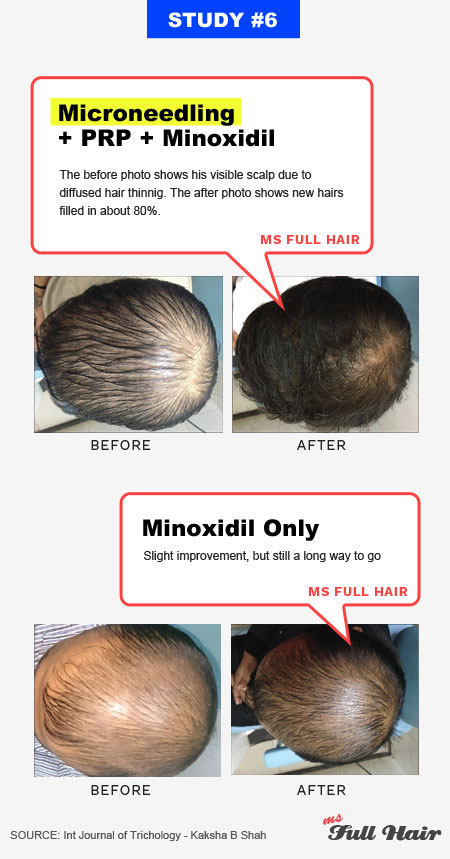
The group B participants who received combination treatments of minoxidil and microneedling with PRP showed a significant increase in hair density compared to group A (minoxidil only group).
Study takeaway
- This study shows that adding PRP treatment to microneedling and minoxidil can be a consideration for hair regrowth.
Microneedling hair loss study #7:
Identifying how minoxidil, PRP, and microneedling affect hair regrowth
This recently published research in 2019 (11) has a better study design than #6.
In the above study, you couldn’t really find out if it was a dermaroller or PRP that accelerated hair growth.
This research resolved that issue by adding an extra comparison group.
90 AGA participants with hair thinning were randomly divided into 3 groups.
Study design:
- Group A: 5% minoxidil
- Group B: 5% minoxidil + PRP
- Group C: 5% minoxidil + PRP + microneedling
The results?
The hair pull test shows that group C (minoxidil + PRP + microneedling) had the most effective outcome by showing negative in 87.1% participants, compared to 64.5% for group B and 48.4% of group A.
The results from self assessment and terminal to vellus hair ratio also reveal that participants in group C had the most improvement compared to the other two groups.
Study takeaway
- PRP + microneedling increases the effectiveness of hair regrowth than using PRP alone
Microneedling hair loss study #8:
Finding out if microneedling helps those who failed to respond to conventional hair loss treatments
This study (12) showcases four men who were non-responsive to conventional hair regrowth therapies including finasteride, minoxidil and hair transplants.
Existing hair loss symptoms:
- Case 1: AGA participant unresponsive to finasteride and minoxidil (done hair transplant)
- Case 2: AGA participant unresponsive to minoxidil and amino acid treatment (done hair transplant)
- Case 3: AGA participant unresponsive to finasteride and minoxidil
- Case 4: Diffused thinning participant unresponsive to conventional therapy (doesn’t specify the therapy)
All four participants did microneedling onto their scalps, as their existing hair loss treatments were not improving hair growth as they were hoping for.
Detailed microneedling procedure:
- Type: 1.5 mm derma roller
- Directions: Longitudinal, vertical and diagonal directions
- Cycles: Roll over the scalp until redness occurs (no specific numbers were mentioned)
- Time : 20-25 minutes of derma rolling
- Frequency: Once a week for the first 4 weeks, then once every two weeks afterward
They were also instructed to start microneedling while continuing with their existing treatments.
Duration: 24 weeks
The result?
Another impressive outcome.
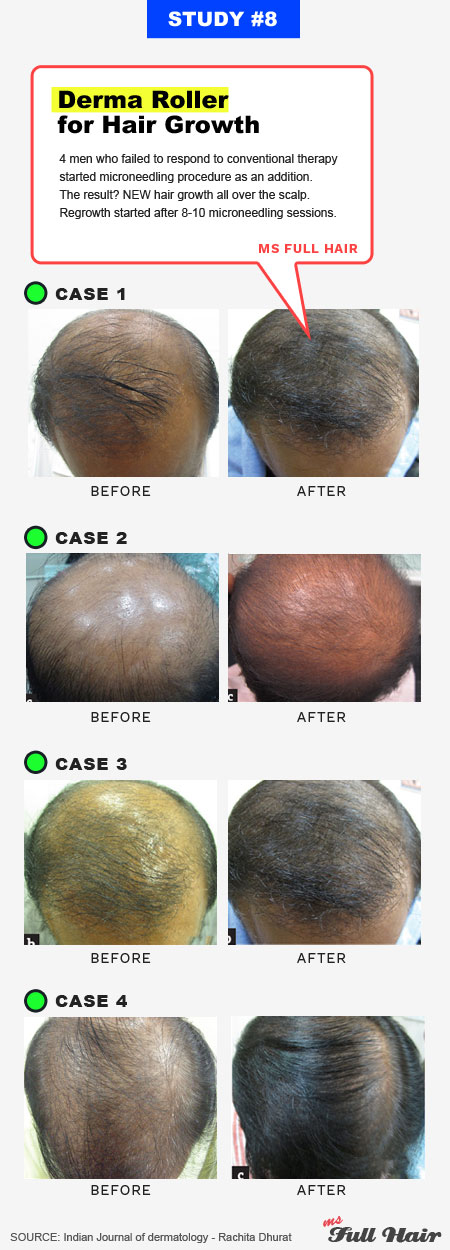
Remember – all of these participants had minimal to no response to conventional hair loss treatments such as minoxidil and finasteride.
A couple of the participants even underwent hair transplant surgery, but ended up with unacceptable results.
The researchers observed that new hairs were sprouting after 3 months.
By 6 months, significant improvement was shown in ALL participants (75% in 3 and 50% in 1 participant).
Study takeaway
- A study shows that even if your hair loss are not responsive to conventional therapies, using a derma roller for hair growth can change that.
Microneedling hair loss study #9 (Ongoing):
Identifying if microneedling for female hair loss is also effective
If you noticed almost all participants from the above studies were male.
This ongoing study solely investigates the effectiveness of using a dermaroller for female hair loss pattern.
We will give you an update once the study issues results.
Summing up ALL studies:
By now, you may ask: “So what’s the bottom line?”
Well, one study after another, then another… it’s very clear: A derma roller INDEED accelerates hair regrowth, even for those who are unresponsive to conventional treatments. And yes… even for alopecia areata in one study.
In the how to section, we will show you exactly how to use a derma roller to maximize hair regrowth and reverse hair loss.
Before we get there, let’s go over the success stories – a derma roller for hair loss reviews from actual users.
5 Success stories of microneedling for hair loss
Microneedling for hair growth success story #1:
This is one of the MOST impressive before and after photos of microneedling for hair loss.
Let’s start with before and after photos first (14):
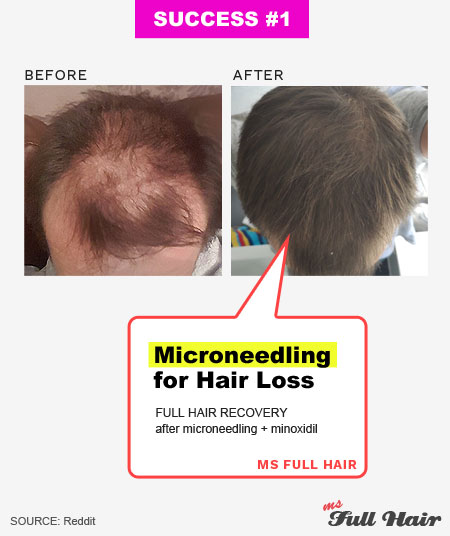
His regrowth secret? It is very simple – minoxidil and microneedling.
His derma roller for hair growth regime:
- Microneedling
- Up to 2 month: 1.5 mm size dermaroller (once a week)
- 2 month – now: dermapen (every 10-14 days)
- 5% minoxidil twice a day (skipping on the day he does microneedling)
He notes that he switched to a dermapen after a couple of months for the sake of convenience, but notes that the derma roller gave him incredible results.
Microneedling for hair growth success stories #2:
This is another great success with a minoxidil and microneedling combo.
Here are the before and after microneedling for hair loss results (15):
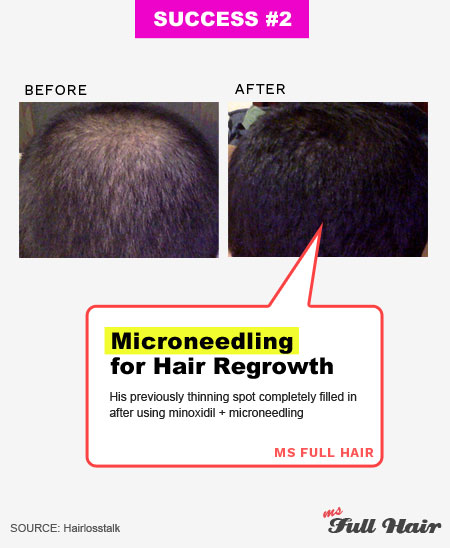
His daily hair regrowth regimen:
- Microneedling – 1.5 mm derminator (once a week)
- Minoxidil – once a day
It only took him 1 month and 20 days to see this rapid hair regrowth.
Microneedling for hair growth success story #3:
This shows another impressive before and after result of microneedling in conjunction with minoxidil treatment (17).
The after photo shows 5 months later:

You can see the bald spot has quickly filled up.
His daily hair regrowth regimen:
- Microneedling – 1.5 mm dermapen (every 10 days)
- Minoxidil – twice a day
He notes that he was unresponsive to minoxidil before starting a dermaroller procedure.
Microneedling for hair growth success story #4:
Unlike many other microneedling reviewers who opt for the minoxidil and microneedling combo, he was able to induce hair regrowth using a natural topical treatment and microneedling (18).

His daily hair regrowth regimen:
- 0.5 mm of 540 disc needle derma roller (once a week)
- Prior to microneedling: Apple cider vinegar rinse + 2% BHA Salicylic
- Topical mix (saw palmetto oil, pumpkin seed oil, and caster seed oil)
Microneedling for hair loss success story #5:
She also benefited greatly from microneedling.
You can clearly see that the side edge (V area) is filled up with thicker hairs (19).
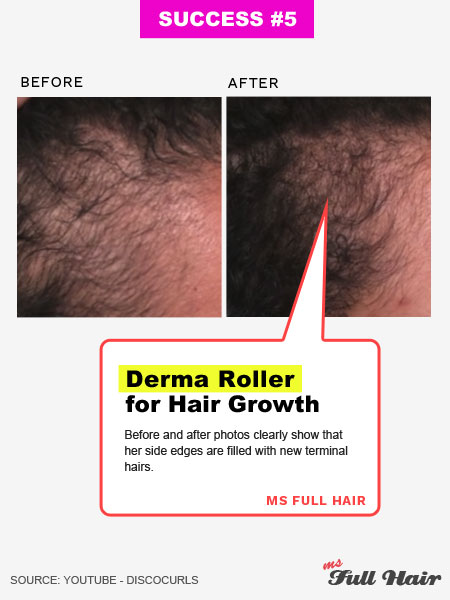
Her daily hair regrowth regimen:
- < 5 months: 0.25 mm derma roller
- 5 months – now: 0.5 mm derma roller
- Essential oil mix (peppermint, tea tree, rosemary,and jojoba oil)
Microneedling side effects for hair
Most researchers from microneedling studies report that microneedling (derma rolling) is considered to be a safe procedure without any side effects.
However, one study notes that as a part of dermaroller for hair side effects, a few participants who were elderly and had weak immune response experienced infection and enlarged lymph nodes after dermarolling, even though there was no treatment required afterwards.
Also, people with the following conditions should not perform microneedling:
- If you have a bleeding disorder
- If you are on anticoagulant or anti-platelet drugs (blood thinners)
- If you are pregnant
It’s also important to sterilize a derma roller by soaking in hot water or more preferably with an alcohol in order to avoid any infection.
Warning: FDA microneedling regulation
Due to the increasing popularity of the needle roller use, the FDA recently issued a mandatory microneedling classification order in 2018 (20, 21).
To summarize, the FDA now classifies microneedles as a medical device if the needle length is greater than 0.3mm.
The FDA states that a microneedling device should not affect the structure and function of the body for home use, which is probably why they specified the allowed needle length – maximum 0.3 mm.
We also read that manufacturing facilities and sellers in the US that are selling derma rollers that have needles longer than 0.3 mm have been receiving cease & desist letters from the FDA.
Dilemma: This creates a small dilemma.
If you remember, many microneedling research studies were based on using a 1.5 mm derma roller for their hair regrowth experiments.
So, is there any solution for at-home users who want to get into microneedling?
Well, unfortunately, the answer is no (unless the FDA changes the regulation. And as you know this is very unlikely).
The best option for now is to use the maximum approved for home use length of 0.3 mm.
A woman from one of the success stories above also used a 0.25 mm derma roller with great hair regrowth results.
Types of derma rollers (and what’s the best dermaroller for hair growth?)
There are currently 3 different microneedling devices available in the market.
- Derma roller
- Derma stamp
- Eletric derma pen
- Our recommendation
Let’s go over each one and talk about the pros and cons of using it for microneedling scalp at home.
Derma roller
This is what most people think of when they hear “microneedling”.
A dermaroller is a little hand-held device with an attached drum that contains needles and it’s designed to be rolled over the skin / scalp.
In fact, many researchers have used this type for their studies with great results.
There are generally two types of derma rollers:
- 540 disc needle derma roller
- 192 (individual) needle derma roller
Let’s talk about each one.
540 needle dermaroller:
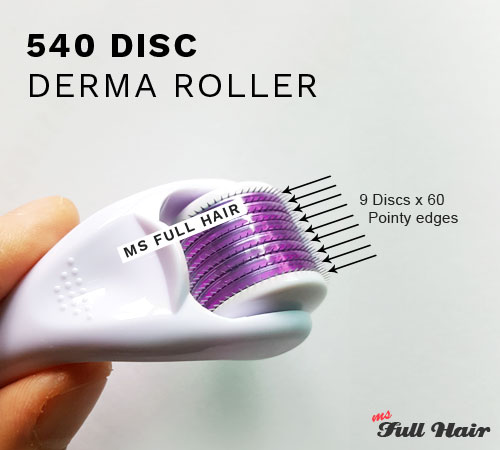
Also known as a disc needle roller, this specific derma roller is actually composed of 9 discs with 60 sharp pointy edges around it on each disc.
If you look around the Internet, you may come across a claim that the 540 needle derma roller is a fake since it’s disc-based and can even damage your skin.
But is that really true that this is a fake dermaroller?
In our opinion, it depends on the length of the needles.
For instance, when you use a disc roller with a 2.5 mm needle length, you will notice the bottom parts of sharp edges on disc are thicker, making them triangular shaped, rather than an actual needle shape.
If you are using this type and it is not greater than 1.0 mm, it’s likely to be ok to use for the purpose of stimulating hair regrowth.
192 needle dermaroller:

This roller is actually made of real individual needles, not the discs.
Most research studies used this derma roller with significant hair regrowth results.
What’s the best dermaroller for hair loss?
While the disc roller is fine to use (as long as the needle length /size is not too long), we recommend a 192 needle derma roller which is made of individual needles, as many research studies opted for this specific type.
Plus, derma rollers are much cheaper than using an electric microneedling derma pen or stamp.
Derma stamp
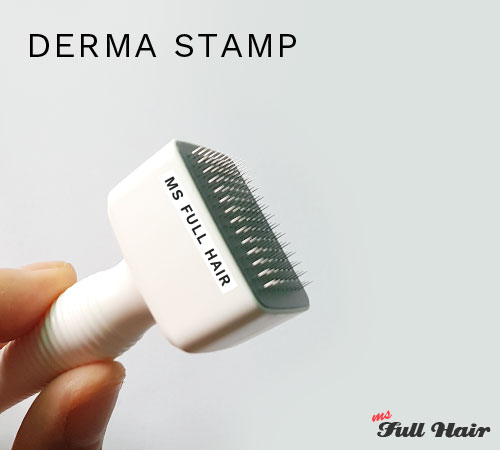
This microneedling device looks just like a stamp (for ink, not mail), but with fine needles attached to the flat surface.
There are two versions of derma stamp available: fixed and adjustable needle length.
Either way, from what we have read so far, the derma stamp is more difficult to use than a derma roller and harder to clean.
Plus, there are no studies that used a derma stamp for their experiments.
Electric microneedling pen
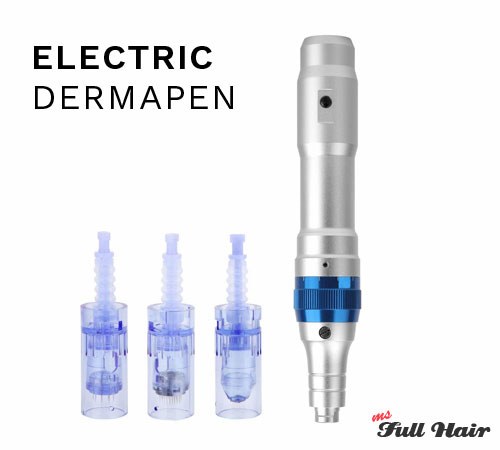
An electric microneedling pen is another popular option among hair loss sufferers.
The needles automatically enter into the skin at a rapid speed and create micro-holes.
People report that it’s less painful to use; however, an electric derma pen is an expensive purchase (usually $200+).
Our ultimate recommendation?
If this is your first time trying microneedling and looking for the best dermaroller for hair regrowth, start with a 192 derma roller. Many research studies also used 192 needle derma rollers with significant results.
How to use a derma roller for hair growth – Stimulating MAXIMUM Hair Regrowth
Here is a guideline of how to perform microneedling for hair loss at home based on research studies and success stories.
Frequency:
- Derma roller: Once a week
- Electric microneedling derma pen: Every 10-14 days
Best microneedling size for hair growth:
- Start with 0.3 mm if you are new to microneedling
- (Optional) Transition to 0.5 mm after 3-4 months
- Studies used a 1.5 mm derma roller, but if this is your first time dermarolling, this may feel very uncomfortable.
Microneedling directions:
Using a derma roller:
- (Optional) Clean your scalp first: Wash or quickly rinse your hair
- (Optional) Apply a numbing cream to the thinning area: Most numbing creams take about 20-30 minutes to reach an effective numbing level. Then use the alcohol to remove the numbing cream.
- Roll over the hair thinning area: longitudinal, vertical and diagonal directions for 5-8 times each. Make sure to roll in one direction (from one side to the other side – not back and forth movement) to avoid hairs getting stuck. If the color of your scalp is still red, it’s an indication to stop. The whole session will take about 20 minutes
- Keep your derma roller sanitized: Use hot water or soak it in an alcohol for 30 minutes after using it. Let it completely dry before you store it.
- Repeat the process once a week
Electric microneedling pen:
- (Optional) Clean your scalp first: Wash or quickly rinse your hair
- (Optional) Apply a numbing cream to the thinning area: Most numbing creams take about 20-30 minutes to reach an effective numbing level. Then use the alcohol to remove the numbing cream.
- Hold the device at a 90 degree angle for full penetration
- Place the microneedler at the beginning of the thinning spot
- Use a small circular motion and slowly move your hand in longitudinal, vertical and diagonal directions
- Unless the instructions state to discard the needles, clean your needle cartridge by soaking in an alcohol for 30 minutes
- Repeat the process every 10-14 days
Micro needling hair regrowth results – How long does it take?
Some people started seeing hair regrowth results in as early as one month. But on average, you should start to see results in 3 months.
Important notes and tips:
- Avoid direct sunlight for a day or two after microneedling
- Do NOT share your derma roller or any micro needling device with anyone else.
- Wet your scalp prior to dermarolling: Soft skin makes it easier for the needles to penetrate into the skin and extends the lifetime of needles.
- As an alternative to a numbing cream, you can also use an ice-pack.
3 Microneedling hair regrowth recipes
Here are 3 microneedling at home hair regrowth recipes. These are simple yet very effective to reverse hair loss.
Recipe #1: Microneedling + minoxidil
All of the studies report that microneedling is the MOST EFFECTIVE when used with topical treatments, especially minoxidil.
There appears to be two ways to do this (depending on which study you are looking at):
- Method #1: Skip minoxidil on the day of microneedling
- Method #2: Apply minoxidil right after microneedling
Most people appear to follow method #1 without side effects in almost all cases.
If you feel cautious, you can also try method #1 (skipping minoxidil on the microneedling day) and follow the microneedling directions stated here.
Directions:
- Microneedling once a week (do not apply minoxidil on the day of microneedling)
- Apply Minoxidil daily (except for the microneedling day – so it will be 6 days a week). Refer to the following for the strength of minoxidil:
- Male: 5% minoxidil liquid
- Female: 2% minoxidil liquid or 5% minoxidil foam
If you plan to try the minoxidil and microneedling duo therapy, it’s recommended to skip minoxidil on the day of microneedling to avoid unwanted infection or inflammation.
Recipe #2: Microneedling + essential oil mix
Dermaroller and castor oil for hair loss: If you want to go with a natural remedy, follow this recipe.
Ingredients:
- 15 drops of Rosemary oil
- 15 drops of Peppermint oil
- 6 tsp (30ml) of castor oil
This will make a 5% essential oil mix. Put the above oils in a dropper bottle.
If you don’t want your mixture to be too thick, replace castor oil with jojoba oil, olive oil, emu oil, or pumpkin seed oil. Any of these oil works great as a hair growth carrier oil.
Refer to our essential / carrier oil dilution ratio chart if you want to make it more potent.
Directions:
- Microneedling once a week (do not apply the essential oil mix on the day of microneedling)
- Apply essential oil daily (except for the microneedling day – so it will be 6 days a week)
- (Optional) Massage your scalp for 5-10 minutes right after applying the essential oil for better absorption
You can also check out our hair growth recipe section and pick other recipes as well.
Also refer to our essential oil mix dilution chart if you plan to make your own concoction.
Recipe #3: Microneedling alone
If you want to try using a derma roller without any topical treatments, using microneedling as a monotherapy also works.
A couple of studies report that microneedling alone also stimulates hair regrowth to some extent.
For this recipe, follow the microneedling directions as mentioned above.
Q&A: Microneedling for hair loss summary
What’s the best derma roller for hair growth?
Go with a 192 needle derma roller.
This derma roller is made of individual needles and it was the most popular option among researchers. However, the 540 disc roller should be ok for hair regrowth as well if the needle length is not greater than 1.0 mm (there are also people having great hair growth results as well).
What size derma roller for hair loss is recommended? (The best derma roller for hair loss size)
While studies used a derma roller with 1.5 mm needle length / depth to induce hair growth on bald spots, this will likely be too long if you are a beginner at micro rolling.
So, if you are looking for a good derma roller hair growth needle size as a beginner, start with 0.25 mm or 0.3 mm.
We came across a number of people using a dermaroller size that is less than 0.5 mm for treating their hair loss symptoms (thinning hairline, forehead, crown, etc) who were satisfied with the results.
If I do the microneedling hair loss therapy, how often should I use for new hair growth?
You will want to do it once a week using a derma roller or every 10-14 days using an electric microneedling pen. For directions, refer to how to microneedle for hair regrowth section.
Can I use a derma roller daily for hair growth?
It’s not a good idea. Microneedling creates small wounds all over the scalp and the healing time is crucial to release hair growth factors and their related genes properly.
Can I use a derma roller after hair transplant?
Yes, people use a derma roller after going through hair transplant to keep their hairs intact, but follow your doctor’s advice on when to begin. After transplants, you may need recovery time.
Also, one study showcased two men who underwent hair transplants without satisfactory results. They started microneedling in addition to their current hair loss therapies (minoxidil, etc) and experienced improvement.
What’s the best microneedling hair growth serum to try?
Studies report that the minoxidil derma roller combination is amazingly effective to grow the lost hair back.
With microneedling, how long to see hair regrowth results?
As mentioned above, some people started seeing results as little as 3 sessions (about 1 month). But in general, it will take about 2-3 months of microneedling (once 7-10 days) to see hair regrowth results.
Can I just use a derma roller to regrow my hair?
Yes. According to one study, using a derma roller as a monotherapy actually increases the number of hair strands. But it’s important to note that hair regrowth was accelerated much faster when used with minoxidil.
What about using a natural topical treatment (ex: essential oil mix) in conjunction with microneedling?
There are currently no studies with the microneedling + natural remedy combination; however, there are dozens of studies showcasing the effectiveness of natural remedies for reversing hair loss. Also, the above success stories suggest that you can regrow hair by using a natural topical mix and a derma roller.
Can I use a dermaroller for alopecia areata?
Yes. According to one study, a derma roller and topical triamcinolone acetonide gave the participants impressive regrowth on previously bald patchy spots. They were previously non-responsive to conventional AA treatments.
Does microneedling hurt?
Generally, people agree that the pain of microneedling is very bearable. In case you are not comfortable with the pain level, use a numbing cream or an ice pack for relief. When using a numbing cream, follow the instructions provided on the cream to avoid issues.
Is the disc needle really that bad?
It depends on the needle length. As long as the needle length is not greater than 1 mm, it shouldn’t be a problem. However, it’s better to use a derma roller that is made of individual needles like this one.
How long does microneedling last if I use it for stimulating hair growth?
Assuming you will use it once a week, it should last 3 – 4 months.
Conclusion – Does microneedling help with hair growth?
The short answer: YES.
Backed by research studies and an increasing number of success stories, all of the evidence points to one thing: Microneedling works surprisingly well for stimulating hair regrowth.
Microneedling works by increasing the permeability of topical treatments, helping with the formation of new capillary networks for better blood circulation, and activating various growth factors crucial for hair follicle development.
Microneedling for hair loss results: If you are resistant to conventional hair loss treatments, consider microneedling at home, whether it’s for hairline, forehead, or even overall thinning.
Quite a number of people who had none to minimal response to existing therapies experienced impressive regrowth results when they started microneedling as an additional step.
Finally, if you are currently a minoxidil user with unsatisfactory results, start microneedling for hair loss once a week as an addition. The dermaroller and minoxidil combo will pick up the speed of new hair growth, according to many study results and people’s experience.
Have you tried a derma roller for hair loss? How did it go? Share your experience in the comments


